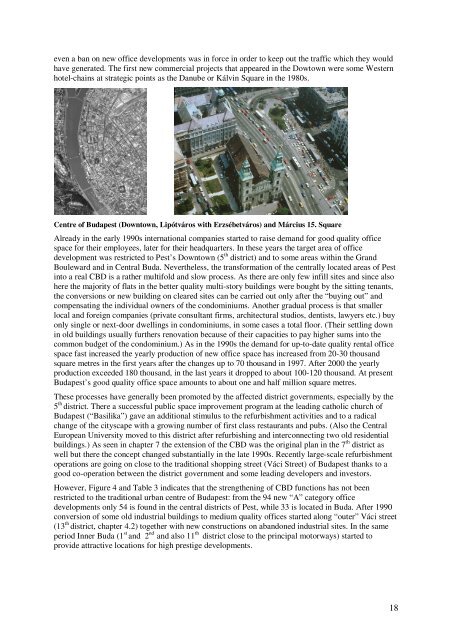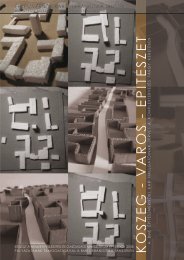even a ban on new <strong>of</strong>fice developments was <strong>in</strong> force <strong>in</strong> order to keep out <strong>the</strong> traffic which <strong>the</strong>y wouldhave generated. The first new commercial projects that appeared <strong>in</strong> <strong>the</strong> Dowtown were some Westernhotel-cha<strong>in</strong>s at strategic po<strong>in</strong>ts as <strong>the</strong> Danube or Kálv<strong>in</strong> Square <strong>in</strong> <strong>the</strong> 1980s.Centre <strong>of</strong> <strong>Budapest</strong> (Downtown, Lipótváros with Erzsébetváros) and Március 15. SquareAlready <strong>in</strong> <strong>the</strong> early 1990s <strong>in</strong>ternational companies started to raise demand for good quality <strong>of</strong>fice<strong>space</strong> for <strong>the</strong>ir employees, later for <strong>the</strong>ir headquarters. In <strong>the</strong>se years <strong>the</strong> target area <strong>of</strong> <strong>of</strong>ficedevelopment was restricted to Pest’s Downtown (5 th district) and to some areas with<strong>in</strong> <strong>the</strong> GrandBouleward and <strong>in</strong> Central Buda. Never<strong>the</strong>less, <strong>the</strong> transformation <strong>of</strong> <strong>the</strong> centrally located areas <strong>of</strong> Pest<strong>in</strong>to a real CBD is a ra<strong>the</strong>r multifold and slow process. As <strong>the</strong>re are only few <strong>in</strong>fill sites and s<strong>in</strong>ce alsohere <strong>the</strong> majority <strong>of</strong> flats <strong>in</strong> <strong>the</strong> better quality multi-story build<strong>in</strong>gs were bought by <strong>the</strong> sitt<strong>in</strong>g tenants,<strong>the</strong> conversions or new build<strong>in</strong>g on cleared sites can be carried out only after <strong>the</strong> “buy<strong>in</strong>g out” andcompensat<strong>in</strong>g <strong>the</strong> <strong>in</strong>dividual owners <strong>of</strong> <strong>the</strong> condom<strong>in</strong>iums. Ano<strong>the</strong>r gradual process is that smallerlocal and foreign companies (private consultant firms, architectural studios, dentists, lawyers etc.) buyonly s<strong>in</strong>gle or next-door dwell<strong>in</strong>gs <strong>in</strong> condom<strong>in</strong>iums, <strong>in</strong> some cases a total floor. (Their settl<strong>in</strong>g down<strong>in</strong> old build<strong>in</strong>gs usually fur<strong>the</strong>rs renovation because <strong>of</strong> <strong>the</strong>ir capacities to pay higher sums <strong>in</strong>to <strong>the</strong>common budget <strong>of</strong> <strong>the</strong> condom<strong>in</strong>ium.) As <strong>in</strong> <strong>the</strong> 1990s <strong>the</strong> demand for up-to-date quality rental <strong>of</strong>fice<strong>space</strong> fast <strong>in</strong>creased <strong>the</strong> yearly production <strong>of</strong> new <strong>of</strong>fice <strong>space</strong> has <strong>in</strong>creased from 20-30 thousandsquare metres <strong>in</strong> <strong>the</strong> first years after <strong>the</strong> changes up to 70 thousand <strong>in</strong> 1997. After 2000 <strong>the</strong> yearlyproduction exceeded 180 thousand, <strong>in</strong> <strong>the</strong> last years it dropped to about 100-120 thousand. At present<strong>Budapest</strong>’s good quality <strong>of</strong>fice <strong>space</strong> amounts to about one and half million square metres.These <strong>processes</strong> have generally been promoted by <strong>the</strong> affected district governments, especially by <strong>the</strong>5 th district. There a successful public <strong>space</strong> improvement program at <strong>the</strong> lead<strong>in</strong>g catholic church <strong>of</strong><strong>Budapest</strong> (“Basilika”) gave an additional stimulus to <strong>the</strong> refurbishment activities and to a radicalchange <strong>of</strong> <strong>the</strong> cityscape with a grow<strong>in</strong>g number <strong>of</strong> first class restaurants and pubs. (Also <strong>the</strong> CentralEuropean University moved to this district after refurbish<strong>in</strong>g and <strong>in</strong>terconnect<strong>in</strong>g two old residentialbuild<strong>in</strong>gs.) As seen <strong>in</strong> chapter 7 <strong>the</strong> extension <strong>of</strong> <strong>the</strong> CBD was <strong>the</strong> orig<strong>in</strong>al plan <strong>in</strong> <strong>the</strong> 7 th district aswell but <strong>the</strong>re <strong>the</strong> concept changed substantially <strong>in</strong> <strong>the</strong> late 1990s. Recently large-<strong>scale</strong> refurbishmentoperations are go<strong>in</strong>g on close to <strong>the</strong> traditional shopp<strong>in</strong>g street (Váci Street) <strong>of</strong> <strong>Budapest</strong> thanks to agood co-operation between <strong>the</strong> district government and some lead<strong>in</strong>g developers and <strong>in</strong>vestors.However, Figure 4 and Table 3 <strong>in</strong>dicates that <strong>the</strong> streng<strong>the</strong>n<strong>in</strong>g <strong>of</strong> CBD functions has not beenrestricted to <strong>the</strong> traditional <strong>urban</strong> centre <strong>of</strong> <strong>Budapest</strong>: from <strong>the</strong> 94 new “A” category <strong>of</strong>ficedevelopments only 54 is found <strong>in</strong> <strong>the</strong> central districts <strong>of</strong> Pest, while 33 is located <strong>in</strong> Buda. After 1990conversion <strong>of</strong> some old <strong>in</strong>dustrial build<strong>in</strong>gs to medium quality <strong>of</strong>fices started along “outer” Váci street(13 th district, chapter 4.2) toge<strong>the</strong>r with new constructions on abandoned <strong>in</strong>dustrial sites. In <strong>the</strong> sameperiod Inner Buda (1 st and 2 nd and also 11 th district close to <strong>the</strong> pr<strong>in</strong>cipal motorways) started toprovide attractive locations for high prestige developments.18
Table 3Location <strong>of</strong> „A” and „B” category <strong>of</strong>fices <strong>in</strong> <strong>Budapest</strong> <strong>in</strong> 2007Category “A” Category “B” “A”+”B”Area (districts) No Per cent No Per cent Per centInner Pest (V.,VI.,VII.,IX.,XIII.) 54 57,4 34 43,1 50,9Buda (I., II., III.,XI., XII.) 33 35,1 25 31,6 33,5O<strong>the</strong>r areas 7 7,5 20 25,3 15,6<strong>Budapest</strong> total 94 100,0 79 100,0 100,0Source: www.irodahaz.<strong>in</strong>foFigure 5Number <strong>of</strong> high quality <strong>of</strong>fice <strong>space</strong>s <strong>in</strong> <strong>Budapest</strong>’s districts <strong>in</strong> 20071816141210864205. 6. 7. 8. 9. 13. 1. 2. 3. 11. 12. 4. 14. 16. 19. 21.category Acategory BSource: www.irodahaz.<strong>in</strong>foIt is ra<strong>the</strong>r suggestive that <strong>the</strong>se locations to a great extent correspond to <strong>the</strong> high status residentialsectors <strong>of</strong> <strong>the</strong> city, described <strong>in</strong> section 2; namely, a substantial part <strong>of</strong> <strong>the</strong> ma<strong>in</strong> CBD functions tend to“move” along <strong>the</strong> ecological sectors <strong>of</strong> <strong>Budapest</strong>. This trend is supported also by <strong>the</strong> number <strong>of</strong>dwell<strong>in</strong>gs converted to <strong>of</strong>fices. Accord<strong>in</strong>g to <strong>the</strong> 2001 national census 10713 <strong>of</strong> <strong>the</strong> 14008 dwell<strong>in</strong>gs(76,5 per cent) “used for o<strong>the</strong>r purposes” was found <strong>in</strong> <strong>the</strong> districts listed <strong>in</strong> Table 2. (The highestfigures are shown by <strong>the</strong> 5 th ,.6 th , 13 th , 2 nd and 11 th districts.) As discussed, this specific feature <strong>of</strong> “CBD<strong>restructur<strong>in</strong>g</strong>” <strong>of</strong> <strong>Budapest</strong> is expla<strong>in</strong>ed by <strong>the</strong> few vacant lots and <strong>the</strong> cumbersome and costlyoperation <strong>of</strong> convert<strong>in</strong>g privatised condom<strong>in</strong>iums, or <strong>the</strong>ir sites, <strong>in</strong>to <strong>of</strong>fices <strong>in</strong> <strong>the</strong> central city <strong>of</strong> Pestand also by <strong>the</strong> <strong>in</strong>tention <strong>of</strong> <strong>the</strong> developers to build <strong>in</strong> environmentally attractive areas where <strong>the</strong> bettertra<strong>in</strong>ed people live.4.2 L<strong>in</strong>ear type radical <strong>restructur<strong>in</strong>g</strong> <strong>processes</strong> along some ma<strong>in</strong> access roadsAs shown <strong>in</strong> <strong>the</strong> former section, two districts, namely <strong>the</strong> 11 th <strong>in</strong> South Buda and <strong>the</strong> 13 th <strong>in</strong> North Pest,present a substantially high share <strong>in</strong> <strong>the</strong> <strong>processes</strong> <strong>of</strong> CBD <strong>restructur<strong>in</strong>g</strong>. In <strong>the</strong>se two districtstransformation <strong>of</strong> land uses are <strong>in</strong>fluenced by a complex set <strong>of</strong> conditions. Both districts are adjacentto <strong>the</strong> river Danube, both are relatively close to <strong>the</strong> city centre. In <strong>the</strong> 13 th district (Újlipótváros,Angyalföld) <strong>the</strong> Metro l<strong>in</strong>e No 3 was built under outer Váci street <strong>in</strong> <strong>the</strong> 1970s, <strong>the</strong> 11 th district(Kelenföld, Lágymányos)is cut through by <strong>the</strong> two pr<strong>in</strong>cipal motorways, No 1 and No 7. In <strong>the</strong> 11 thdistrict three important distributor roads (one <strong>of</strong> <strong>the</strong>m newly opened) lead to <strong>the</strong> sou<strong>the</strong>rn parts <strong>of</strong>Buda and to <strong>the</strong> motorway No 0 (<strong>the</strong> outer r<strong>in</strong>g). In both districts <strong>the</strong> 19 th century <strong>in</strong>dustrialdevelopment followed <strong>the</strong> l<strong>in</strong>e <strong>of</strong> a pr<strong>in</strong>cipal road (outer Váci Street and Budafoki Street respectively)bordered with <strong>in</strong>dustrial plants along <strong>the</strong> river Danube that used to be serviced also by railway. Ow<strong>in</strong>gto <strong>the</strong>ir highly advantageous position <strong>the</strong>se two areas became <strong>the</strong> scene <strong>of</strong> <strong>the</strong> first “brown-field<strong>restructur<strong>in</strong>g</strong>” <strong>processes</strong> after 1990.The 13 th district <strong>of</strong> <strong>Budapest</strong> is made up <strong>of</strong> two dist<strong>in</strong>ct areas. Its South part <strong>in</strong>cludes <strong>Budapest</strong>’s mostvaluable high density residential area (Újlipótváros) built <strong>in</strong> <strong>the</strong> between war period. Its nor<strong>the</strong>rn part(Angyaföld/Angels field) used to be a real workers district with 10 <strong>of</strong> <strong>the</strong> 18 most important19
- Page 1 and 2: Large-scale restructuring processes
- Page 3 and 4: 7. Inner-Erzsébetváros, restructu
- Page 5 and 6: 1. An overall gentrification proces
- Page 7 and 8: Józsefváros’s (8 th district) l
- Page 9 and 10: no, or only very short “time-span
- Page 11 and 12: A special population group in Budap
- Page 13 and 14: 2. Other specific factors influenci
- Page 15 and 16: Only in few cases this expectation
- Page 17: (1.017,4 million non-repayable subs
- Page 21 and 22: investors has proved to be rather s
- Page 23 and 24: they were sold to Hungarian and for
- Page 25 and 26: offers a 5 thousand sq metre “bon
- Page 27 and 28: ambitious programs of relocation of
- Page 29 and 30: district, North-East Csepel: 21 st
- Page 31 and 32: 4.6 Brown-field areas with limited
- Page 33 and 34: see”. It holds its more then 10 h
- Page 35 and 36: Map 4Restructuring processes in Bud
- Page 37: severe in Ferencváros where the Di
- Page 40 and 41: emain exemptions as nowhere else in
- Page 42 and 43: XVII, along Pesti road was the firs
- Page 44 and 45: the company was able to tide over h
- Page 46 and 47: principal task remained the develop
- Page 48 and 49: Two plans of Madách (Erzsébet) Av
- Page 50 and 51: the share of Jewish people grew fas
- Page 52 and 53: study (Coopers & Lybrand). Accordin
- Page 54 and 55: this principle caused serious confu
- Page 56 and 57: external, that is private, sources.
- Page 58 and 59: in 2005 and 2006. Instead of puttin
- Page 60 and 61: per cent by blocks). Social status
- Page 62 and 63: 7.9 Management of renewal by the Di
- Page 64 and 65: The effort to concentrate subsidies
- Page 66 and 67: • management of the publicly owne
- Page 68 and 69:
The system of pedestrian streets in
- Page 70 and 71:
Figure 11/BPartnership relations in
- Page 72 and 73:
uilding industries was only 17,7 pe
- Page 74 and 75:
ather promising. (As part of the la
- Page 76:
Musterd, S, and Weesep, J. (1991) E






